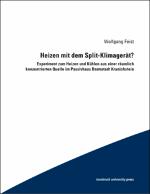Heizen mit dem Split-Klimagerät?
Experiment zum Heizen und Kühlen aus einer räumlich konzentrierten Quelle im Passivhaus Darmstadt Kranichstein
| dc.contributor.author | Feist, Wolfgang | |
| dc.date.accessioned | 2022-06-24T07:43:57Z | |
| dc.date.available | 2022-06-24T07:43:57Z | |
| dc.date.issued | 2022 | |
| dc.identifier | OCN: 1346794995 | |
| dc.identifier.uri | https://library.oapen.org/handle/20.500.12657/57093 | |
| dc.description.abstract | The energy transition requires a conversion of the heating systems in almost all buildings from the fossil-dependent, fuel-powered boilers to, ideally, completely renewable heat generation. Because the development of significant amounts of renewable energy is easiest via power generation systems (wind turbines, photovoltaics, hydroelectric power) and also the necessary use of renewable fuel to a certain extent (be it wood or other biomass or renewable synthesized fuels i.e. PtG) should be done in combined heat and power generation, in the future electricity will be the preferred source for the operation of new or replaced heating systems. Direct use of electricity (resistance heaters) is out of the question because of the low efficiency - heat pumps are the preferred energy converters here. Heat pumps scale in the purchase price, in the heat source exploitation and in installation costs noticeably with the heat output to be installed. It is therefore advisable to initially reduce the heat demand of a heat pump heated building as much as possible. This is achieved in a new building with the passive house and in existing buildings with the so-called EnerPHit-modernization. | en_US |
| dc.language | German | en_US |
| dc.subject.other | Physics; Heating; Energy; Passive House | en_US |
| dc.title | Heizen mit dem Split-Klimagerät? | en_US |
| dc.title.alternative | Experiment zum Heizen und Kühlen aus einer räumlich konzentrierten Quelle im Passivhaus Darmstadt Kranichstein | en_US |
| dc.type | book | |
| oapen.identifier.doi | 10.15203/99106-078-9 | en_US |
| oapen.relation.isPublishedBy | 7e4aa047-ebd5-4269-b6c8-a86925324b93 | en_US |
| oapen.collection | AG Universitätsverlage | |
| oapen.pages | 62 | en_US |
| oapen.place.publication | Innsbruck | en_US |

